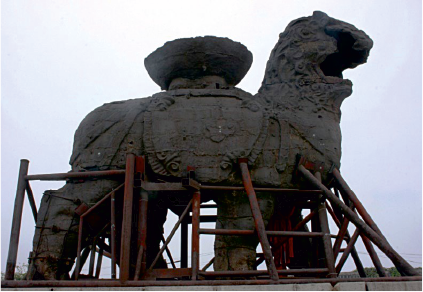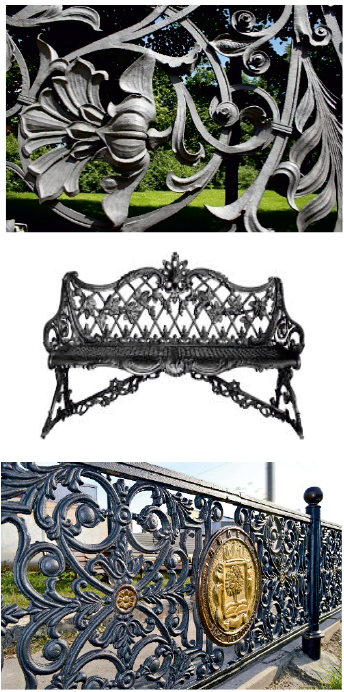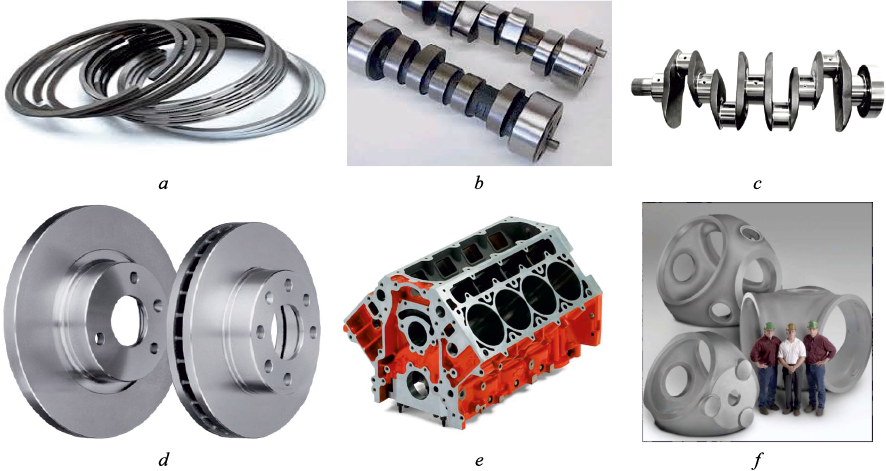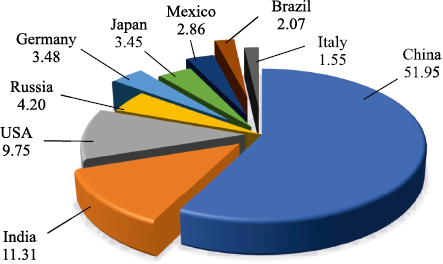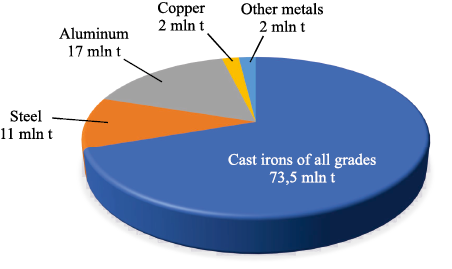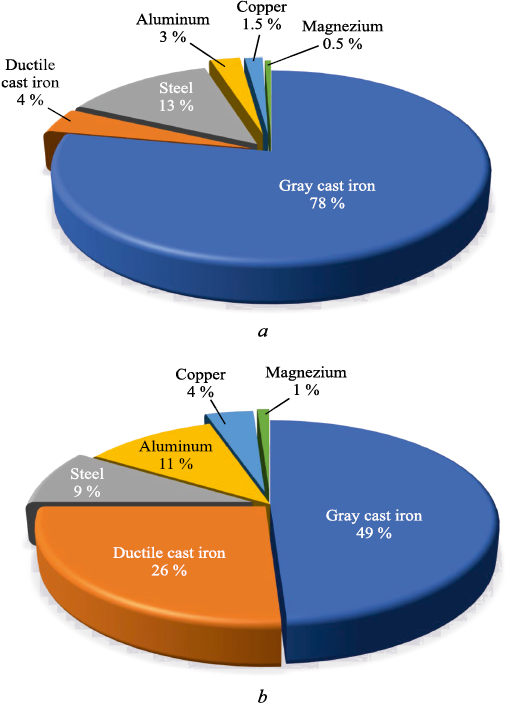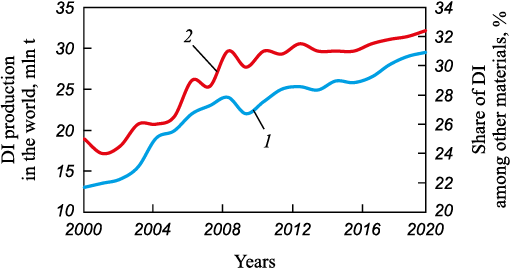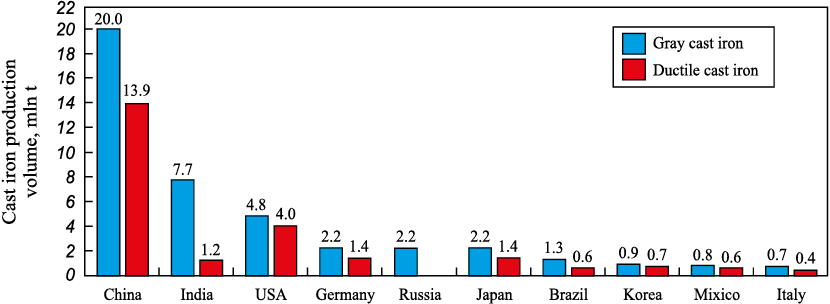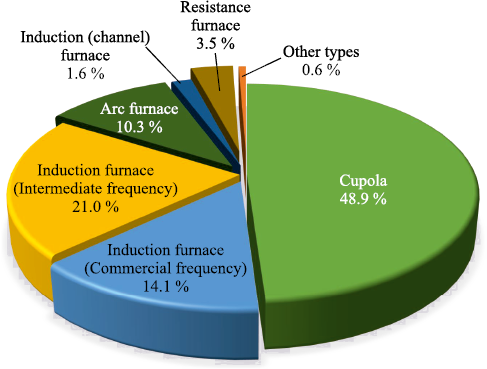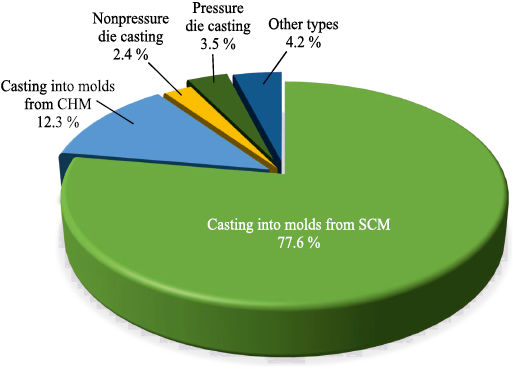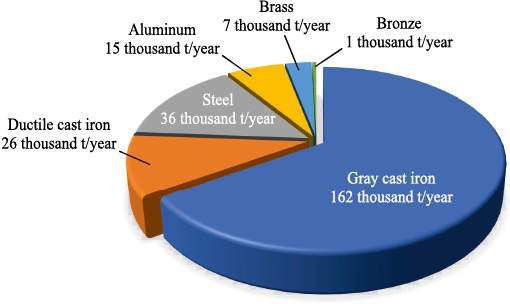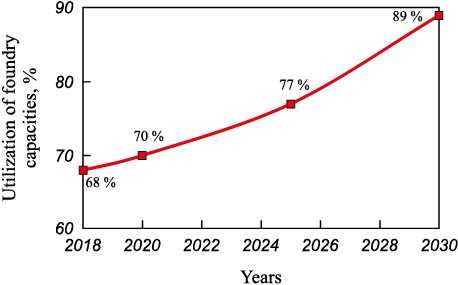Scroll to:
Features of iron foundry production in Belarus and its prospects
https://doi.org/10.17073/0368-0797-2024-1-8-18
Abstract
A historical overview of the development of iron foundry production in the world is presented. The modern level of the material structure in iron casting has an outstripping growth of ductile cast iron grades. The paper describes the features of iron foundry production in Belarus. Technologies and equipment are significantly inferior to foreign ones in terms of productivity and specific resource costs per unit of product. The specific character of Belarus lies in the still widespread use of cupolas, molds from sand-clay mixtures, predominant use of gray cast iron, and small volumes of ductile cast iron production. The total capacity of all foundries is 557.5 thousand tons of casting per year, but the peculiarity is that only about 250 thousand tons per year are actually produced. Development and implementation of the “Program for the Development of Foundry Industries of the Republic of Belarus for years 2017–2030” made it possible to ensure more efficient operation of the foundry industry in the country. In the near future Belorussian foundry industry will reproduce the global trend for critical casting products: transfer to ductile cast iron instead of gray one and further transition to ausferritic (bainitic) cast iron instead of rolled steel.
For citations:
Vityaz’ P.A., Zalesskii V.G., Pokrovskii A.I. Features of iron foundry production in Belarus and its prospects. Izvestiya. Ferrous Metallurgy. 2024;67(1):8-18. https://doi.org/10.17073/0368-0797-2024-1-8-18
Introduction
Cast irons, or high-carbon iron alloys, have been acknowledged and extensively utilized since the initial millennium BC.
It is widely held among scholars that the Russian phrase “cast iron” is derived from the Chinese words “zhu” (meaning “to cast (metal)”) and “gong” (meaning “work”). The advent of iron smelting technology in China is purported to trace back to the 5\(^\rm{th}\) to 3\(^\rm{rd}\) centuries BC. This process involved the use of ball iron and charcoal, with smelting occurring at temperatures exceeding 1200 °C over several days. Subsequently, Chinese metallurgists developed a specialized furnace for melting cast iron from either highly phosphoric iron ore or ball iron, known as the “Chinese” cupola. This furnace essentially functioned as a 1 m tall chimney, equipped with a forced-air system to enhance air flow.
China excelled in producing intricate castings from cast iron. A noteworthy example is the lion statue (Fig. 1) believed to have been cast in 954 and placed in the Jiangzhou district of Chongzuo Township, Guangxi Zhuang Autonomous Region. The dimensions of this casting, which is over a millennium old, continue to astonish metallurgists today. Replicating the statue presents a formidable challenge for many contemporary foundries (the sculpture measures 5.4 m in length, 3 m in width, 5.4 m in height, weighs 44 tons, and has wall thicknesses ranging from 4 to 20 cm). The figure was created using a life-sized clay model. Experts suggest that it was a single-piece casting, likely achieved by melting metal in multiple cupolas simultaneously, which then flowed through channels into one mold.
Fig. 1. 44-ton solid cast iron casting of a lion made in 954 in China |
The earliest instances of cast-iron objects in Europe date back to the 14\(^\rm{th}\) century. The late 15\(^\rm{th}\) century saw the emergence of the first bloomery furnaces in Italy, the Netherlands, and Belgium. Fig. 2 illustrates the first cast-iron bridge, constructed in 1779 in England, spanning the River Severn.
Fig. 2. The first cast iron bridge built in 1779 in England across Severn river |
The production of cast iron in Russia commenced in the 16\(^\rm{th}\) century, with Russian artistic iron casting gaining widespread acclaim (Fig. 3).
Fig. 3. Examples of artistic castings |
Into the 21\(^\rm{st}\) century, cast iron maintains its status as a primary and highly favored structural material [1]. Fig. 4 displays several examples of common mechanical engineering components made from cast iron, ranging from small piston rings to large casings for modern wind turbines.
Fig. 4. Examples of typical engineering parts made from cast iron: |
Current global casting industry: A concise summary
The World Foundry Organization [2] monitors casting activities globally, and Modern Casting magazine publishes comprehensive overviews. It’s essential to recognize that statistical reports are subject to delays, meaning the most recent data might be one or sometimes two years old.
In 2018, the world experienced its peak in castings production, surpassing an impressive 112.7 million tons [3]. Recent years have seen a slight decrease in production, with figures showing a 4 – 6 % drop (109.1 million tons in 2019 compared to 105.5 million tons in 2020). Current data indicate that the global output for all casting grades consistently exceeds 100 million tons [4].
The distribution of casting output across various metallic materials in the top ten advanced countries for the year 2020 [3] reveals China as the leading nation, contributing more than half of the world’s casting tonnage, followed by India and the USA, with Russia, Germany, Japan, Mexico, Brazil, and Italy (Fig. 5).
Fig. 5. Distribution of casting output of all materials |
This chart suggests a trend where environmentally harmful foundry operations are gradually relocating from advanced and wealthy nations to less developed ones. Japan’s journey from being the third-largest producer of castings in the world during the 1970s to relocating its production to India, China, and Taiwan in more recent years exemplifies this trend.
State of global iron casting: A contemporary analysis
Within the material composition of all castings, cast iron notably surpasses all other casting materials, constituting over 70 % of the total production. Following cast iron, aluminum castings hold the second spot in output volume, and steel castings are in the third position on a global scale (Fig. 6).
Fig. 6. Structure of world production of castings by the type of material for 2020 [5] |
Increasing prevalence of high-quality and ductile iron over gray cast iron
The shift in production from gray cast iron (GI) to ductile cast iron (DI) became prominent around the late 1970s and early 1980s. This transition was significantly influenced by the discovery made by Keith Dwight Millis. On May 7, 1948, Millis presented his groundbreaking work at a convention of American foundrymen. He demonstrated that the introduction of small quantities of magnesium into molten iron during casting resulted in the formation of spherical graphite inclusions within the iron. This change in the microstructure leads to a marked improvement in the strength properties of the material, potentially doubling its toughness. K. Millis’ patent [5] marked the beginning of the ductile cast iron age.
Fig. 7 reveals significant shifts in the composition of materials used for castings internationally across five decades, from 1996 to 2016.
Fig. 7. Comparison of material structure |
The data illustrated in these diagrams indicates a slight decrease in steel castings production, contrasted with a significant rise in the production of DI castings. Currently, ductile iron castings comprise more than 25 % of all global castings (Fig. 7, b), with the increase largely owing to the enhanced durability of certain cast iron grades.
Furthermore, the trend line in Fig. 8 affirms that, despite various global economic challenges, the production of DI has shown a remarkably stable increase over the recent years [6].
This graph serves as a crucial visual aid for metallurgists, enabling the prediction of an increased demand for ductile iron in the forthcoming years.
Fig. 8. Dynamics of world production of ductile |
Fig. 9 illustrates the production ratio between GI and DI in ten of the leading countries in this industry globally.
In numerous nations, the output of DI constitutes at least half of the production of GI. Notably, in several developed countries, the production of DI surpasses that of GI by a substantial margin. For example, in 2019 Austria’s production of DI reached 104,700 tons, dwarfing its GI output of 42,300 tons, while Spain manufactured 663,000 tons of DI compared to 362,600 tons of GI.
Fig. 9. Ratio of production of gray cast and ductile iron for ten |
This trend indicates a renaissance for cast irons, as their use pivots to high-loaded components within crucial technical sectors such as the automotive industry, railroad, pipeline transport, machine tool production, and shipbuilding. Cast irons are no longer confined to traditional applications like cylinder blocks, piston rings, crankshafts, and camshafts. Recent advancements have broadened their applications, including parts once deemed unsuitable for ductile iron. Internationally, companies such as Ford and Chrysler utilize DI in heavy trucks’ final drive pinions, Zanardi uses it in railway coach suspension parts, and it’s a choice material for soil cultivation implements, among others. Interestingly, due to its superior workability and robust strength characteristics, cast material is starting to replace alloyed steel rolled products that undergo multiple metallurgical processes, a shift particularly noticeable in the leading sectors of mechanical engineering.
Analysis of the cast iron industry in Belarus
During the era of the Soviet Union, Belarus was often referred to as the country’s “assembly shop” due to its highly developed manufacturing sector, particularly in blank production and the foundry industry. In the 1980s, Belarus’s annual output exceeded 1 million tons of various types of castings, with iron castings making up approximately 700,000 tons of this total. In 1985, the per capita production of castings in Belarus was 100 kg, ranking the country third in the world at that time based on this metric.
At present, the output of castings in Belarus has diminished to a quarter of what it was during its peak production years. In 2018, the country’s total casting production was just 250,000 tons.
Several characteristics define the current state of the iron foundry industry in Belarus:
– the technologies and equipment in Belarusian foundries are generally less productive and more resource-intensive per product unit compared to those abroad;
– over half of the iron castings are made using mechanized casting conveyors that are equipped with outdated machinery;
– the capital assets are extensively worn and outdated, with a low rate of renewal (2 – 3 %), and the furnace fleet is antiquated;
– foundry operations consume a high amount of energy;
– there is a minimal inflow of direct investment and technology;
– the foundries are not operating at full capacity; they currently produce 250,000 tons of castings, yet have the capacity to produce 557,500 tons;
– the capacity at Belarusian foundries allows for the production of 345,700 tons of gray iron castings and 73,100 tons of ductile iron castings annually.
The majority of GI and DI castings are produced at key plants such as:
– OJSC “Minsk Tractor Works”;
– OJSC “Minsk Automobile Plant” – Managing Company of “Belavtomaz” Holding;
– OJSC “Centrolite” Gomel Foundry”;
– OJSC “Gomel plant of casting and normals”;
– OJSC “Mogilevliftmash” – Managing Company of the Holding”;
– OJSC “Managing Company of the Holding, Minsk Motor Plant”, Stowbtsy.
The remainder of the cast iron production, accounting for about 25 %, comes from other enterprises in the country.
Fig. 10’s diagram detailing the distribution of casting methods indicates that cupolas, comprising half of the foundry furnace fleet in Belarus, are incapable of producing high-grade cast iron and are significant contributors to dust and gas emissions. The other half of the furnace infrastructure consists of induction furnaces, which are subdivided almost equally among commercial frequency, intermediate frequency, and channel furnaces.
Fig. 10. Distribution of castings in Belarus according to the smelting method |
Yet, modern intermediate frequency induction furnaces have been adopted by several enterprises within Belarus, including: CJSC “Altant” subsidiary – Baranovichi Machine-Tool Plant, OJSC “Minsk Tractor Works”, “Minsk Automobile Plant” – Managing Company of “Belavtomaz” Holding, OJSC “Gomel plant of casting and normals”, OJSC “Centrolite” Gomel Foundry”, OJSC “BELAZ” – Managing Company “BELAZ-HOLDING”, OJSC “Lida Foundry and Mechanical Plant” and OJSC “Managing Company of the Holding “Minsk Motor Plant”.
The analysis of casting distribution by molding methods (Fig. 11) reveals that approximately 78 % of molds are fashioned from sand-clay mixtures. This method is prevalent due to the low cost of raw materials. However, it has significant disadvantages, including high energy consumption, the cost per ton of castings, and less precise casting surfaces. Castings produced in cold-hardening mixtures (CHM) molds constitute about 12 % and offer cleaner surfaces and more accurate geometric dimensions. Despite this advantage, the preparation of these mixtures often involves technologies and equipment that fall short of contemporary standards for molding and core sand mixtures.
Currently, around 10 vortex-type mixers are operational within Belarus, notably at enterprises such as OJSC “Minsk Automobile Plant” – Managing Company of “Belavtomaz” Holding and OJSC “Centrolite” Gomel Foundry”. These mixers have significantly optimized energy usage, cutting it by 1.5 times per ton of mixture, and reduced the need for binding components by 15 – 20 %.
Fig. 11. Distribution of casting in Belarus by forming methods |
The Belarusian foundry industry has also embraced other technological advancements:
– automatic molding lines are in use at several facilities, including OJSC “Minsk Tractor Works”, OJSC “Gomel plant of casting and normals”, CJSC “Altant” subsidiary – “Baranovichi Machine-Tool Plant”, and OJSC “Centrolite” Gomel Foundry”;
– core making machines, specifically employing the “cold-box-amine process,” have been implemented, with OJSC “Minsk Tractor Works” operating more than 30 machines and “Minsk Automobile Plant” – Managing Company of “Belavtomaz” Holding utilizing 4 machines developed by OJSC “BELNIILIT”.
Gray cast iron predominates in the material structure of Belarusian castings (Fig. 12).
Fig. 12. Structure of castings produced in Belarus |
In 2017, the “Foundry Development Program for the period 2017 – 2030” was launched, targeting significant enhancements in the sector’s efficiency and overcoming the aforementioned issues. The program’s primary objectives include:
– optimizing the operations of existing foundries, enhancing product quality, lowering production costs, and maximizing the utilization of foundry capacities;
– fostering the growth of financial and economic performance indicators within organizations;
– producing competitive products that fulfill consumer requirements;
– improving working conditions, minimizing environmental impact from production activities, continuously enhancing environmental standards, and promoting the efficient use of resources.
Initially, an audit of the existing production facilities’ technical standards was conducted as part of this program. Foundries that either met or were close to meeting the technological requirements for castings and could be updated with minimal expense were identified as basic foundries. This classification was in line with the Ministry of Industry’s Order No. 449, issued on December 9, 2016, titled “On Optimization of Foundries.” Focusing on the development of these basic foundries is expected to significantly enhance the foundry industry’s performance in Belarus, enabling the fulfillment of international orders, generating foreign currency revenue, and establishing a reliable reputation for producing quality products at reasonable prices.
Initiatives for the development and modernization of primary foundries in Belarus
Following the directives from the Ministry of Industry’s Order No. 449, issued on December 9, 2016, updates were made to the modernization plans for foundries through to 2030. This involved revising the list of foundries scheduled for preservation or integration into base organizations by transferring their production lines, including the assortment of castings, as well as their melting, molding, mixing, and additional foundry equipment.
A Table details the operational parameters and capacity utilization of primary enterprises involved in the production of gray and ductile iron as of October 1, 2022.
Characteristics and utilization of capacity of the foundry production
|
Fig. 13 illustrates the comparative analysis of both actual and projected capacity utilization across the foundational foundries in Belarus, encompassing all casting categories.
Fig. 13. Dynamics (actual and forecast for 2023 – 2030) of changes in the utilization |
The “Foundry Development Program for the period 2017 – 2030” includes investment initiatives and actions aimed at the establishment of new facilities and the enhancement of existing foundries within principal organizations.
It is proposed to incrementally reallocate the current product spectrum to these central entities and discontinue foundry operations at locations including OJSC “Minsk Automatic Lines Plant” named after P.M. Masherov, OJSC “Gomel Radio Plant”, OJSC “MPOVT”, among others. Furthermore, due to economic non-viability, OJSC “Bobruisk Machine-Building Plant” and JSC “Managing Company of Lidselmash Holding” will cease the production of gray iron castings.
Human workforce strategy in Belarusian foundry industry
In the Republic of Belarus, the training of personnel for the foundry industry is conducted by the following higher education institutions:
– the Faculty of Mechanics and Technology at the Belarusian National Technical University offers degree in: “Machines and technology of foundry production”, “Metallurgical production and material processing”, with specialization in “Foundry of ferrous and non-ferrous metals”;
– the Faculty of Mechanics and Technology at Sukhoi State Technical University of Gomel offers degree in “Machinery and technology of foundry production”, with specializations in “Technical operation of foundry equipment”, “Organization and management of foundry production”, “Metallurgical production and material processing” and “Electrometallurgy of ferrous and non-ferrous metals”;
– Gomel State Machine-Building College offers secondary vocational education with a major in “Metallurgical Production and Material Processing,” specializing in “Foundry Production of Ferrous and Non-Ferrous Metals”.
The state sector-specific educational institution of the Ministry of Industry of the Republic of Belarus, named “Institute of Professional Development and Retraining of Managers and Specialists “Industrial Personnel”, is responsible for the advanced training and retraining of managers and specialists within the engineering and technical services sector.
Examples of foundry modernization in Belarus
Examples of basic foundries’ modernization efforts in the Republic of Belarus as of January 1, 2023, include:
OJSC “Minsk Tractor Works”. Modernization efforts in Foundry Shop No. 1, including the molding and melting sections, and the melting section of Shop No. 2, have led to the procurement and installation of two induction furnaces along with charge preparation equipment. Construction and installation works are nearing completion, with commissioning 60 % finished. Completion is anticipated within 2023.
OJSC “Minsk Automobile Plant”. The reconstruction of the iron foundry block, targeting the gray iron section, commenced in 2021, with a projected completion in 2026. Additionally, the ductile iron section began reconstruction in 2023, with an expected finish in 2026.
OJSC “Centrolite” Gomel Foundry”. The continuous mixer with a capacity of 30 t/h aimed at modernizing the heavy casting section, is being installed with an expected completion between 2018 and 2023. For the small casting shop, aiming to enhance competitiveness in large-format casting production, a molding line is acquired with a completion timeframe from 2025 to 2030. The smelting shop is undergoing upgrades by replacing three induction crucible furnaces IChT10 with a complex of intermediate frequency induction furnaces with an 8 t/h capacity.
OJSC “Mogilevliftmash”. Replacing a commercial frequency induction crucible furnace (IChT10) with an intermediate frequency induction furnace, with modernization extending from Q4 2022 to Q4 2023. The core-making section’s upgrade is planned for Q1 2024 to Q1 2025.
OJSC “Mogilev Metallurgical Works”. The foundry shop being reconstructed to accommodate the production of castings from gray and ductile cast iron, with a projected completion from Q1 2026 to Q4 2030.
OJSC “Gomel plant of casting and normals”. Acquisition and installation of a medium-frequency melting furnace with a 20 – 25 tons capacity are part of the ductile iron shop’s smelting section modernization, aiming to replace an outdated commercial frequency induction furnace. Completion is expected between 2024 and 2027.
OJSC “Managing Company of the Holding, “Minsk Motor Plant”, Stowbtsy. The “Production of high-precision ductile iron castings” investment project has been implemented, with completion spanning from 2012 to 2025. The facility is operational, with start-up and commissioning works fully completed as of September 2, 2020. The contract with GUSS-EX (Poland) has been fulfilled, and the setup for producing castings in the small series casting section using the Hardening Tag-Sand Process is underway, aiming for design capacity by Q4 2022.
Future directions for ausferritic cast iron application in Belarus
The global market is currently experiencing a surge in the production of Austempered Ductile Iron (ADI), a variant of ductile cast iron that undergoes a specific heat treatment to achieve an ausferritic metal matrix structure. This material effectively competes with high-quality rolled alloys steels, boasting strengths up to 1400 MPa. Industrially, hundreds of different part sizes are being produced, notably by corporations such as General Motors and Ford, with gears being one of the most extensively manufactured products internationally.
In Belarus, efforts by L.R. Dudetskaya and A.I. Pokrovsky have been made to adopt bainitic cast iron for manufacturing specific components, particularly medium and large gears, within the foundry shop of Minsk Automobile Plant. The technology was applied to the production of rear axle differential gears for the MAZ 5336 model: the axle drive gear (No. 5336-2402050) and the pinion gear (No. 5336-2402055) [8 – 12]. The findings from these applications demonstrated that bainitic cast iron could serve as a viable alternative to the traditionally used 20KhN3А steel for gears. A number of bainitic and ausferritic cast iron compositions have been patented [13 – 17].
The appraisal survey conducted in November 2016, under the directive of the Ministry of Industry of the Republic of Belarus and distributed to over 70 subordinate organizations, identified a yearly demand for bainitic cast iron of approximately 10 thousand ton.
Conclusions
The foundry sector in Belarus is contending with outdated technologies and equipment that lead to lower productivity and higher specific resource consumption per product unit compared to international counterparts. Characteristically, the industry heavily relies on traditional practices such as the use of cupolas and sand-clay mixture molds, with a predominant focus on gray cast iron and limited ductile cast iron production.
A notable issue within Belarusian foundries is the underutilization of capacity. With a total capacity of 557.5 thousand tons for casting annually, the current production stands at only approximately 250 thousand tons – a gap that reflects a significant underuse of available resources. This situation presents an opportunity to align with global trends and fill the capacity with orders from technologically advanced nations, leveraging the shifts in countries like India and China, which are expanding their foundry productions. Efforts must be concentrated on attracting more customers and investors interested in contributing to the advancement of new technologies within the foundry in Belarus.
Efforts to mitigate these challenges are embodied in the “Foundry Development Program for the period 2017 – 2030”. This initiative aims to modernize the entire foundry landscape, designate and revitalize the most competitive foundries as primary operations, devise remodeling plans, and enhance overall efficiency. The program’s implementation is structured to boost the nation’s foundry industry, secure international orders, and enhance foreign currency inflows.
A key direction for modernizing the foundry industry in Belarus involves relocating foundry operations away from Minsk, such as those at Minsk Tractor Works and Minsk Automobile Plant, and establishing modern, high-tech production facilities built from the ground up to meet the latest global standards. A prime example of this initiative is the construction of the Belarusian Metallurgical Plant in Zhlobin.
Belarus boasts a robust educational framework for metallurgy and casting, with professional training provided by the Faculties of Mechanics and Technology at both the Belarusian National Technical University and Sukhoi State Technical University of Gomel, as well as at Gomel State Mechanical Engineering College and Zhlobin State Metallurgical College. The “Foundry Development Program for the period 2017 – 2030” stipulates the targeted number of student enrollments in these disciplines. Additionally, the “Institute of Professional Development and Retraining of Managers and Specialists ‘Industrial Personnel’” oversees the continual professional development and skill enhancement of technical service managers and specialists.
Looking ahead, it is anticipated that Belarus will align with the international shift towards manufacturing critical castings predominantly from ductile cast iron instead of gray cast iron and will progressively move towards using ausferritic (bainitic) cast iron as an alternative to rolled steel. Thus, it is crucial to prepare the industrial infrastructure and the specialists within the field.
References
1. Svidunovich N.A., Vityaz’ P.A., Voitov I.V., Kuis D.V., Myurek M.N. Selection and Applications of Materials: A Tutorial. Vol. 5: Selection and Applications of Cast Irons. Minsk: Belaruskaya navuka; 2020:425. (In Russ.).
2. World Foundry Organization – WFO. Available at URL: https://www.thewfo.com/
3. Total casting tons hits 112 million. Modern Casting. 2019;(December):22–25.
4. Global casting production worldwide. Available at URL: https://www.statista.com/statistics/237526/casting-production-worldwide-by-country
5. Patent US2485760. Cast ferrous alloy. Millis K.D., etc. Oct. 25, 1949.
6. Global casting production growth stalls. Modern Casting. 2017;(December):24–28.
7. Total casting tons dip in 2019. Modern Casting. 2021;(January):28–30.
8. Dudetskaya L.R., Pokrovskii A.I., Gaukhshtein I.S., Demin M.I., Gurchenko P.S. Bainitic cast iron: experience in production and application. Avtomobil’naya promyshlennost’. 2001;(11):33–35. (In Russ.).
9. Dudetskaya L.R., Pokrovskii A.I., Gaukhshtein I.S., Demin M.I., Gurchenko P.S. Heat treatment for bainitic structure of cast iron parts. Lit’e i metallurgiya. 2002;(1):45–49. (In Russ.).
10. Pokrovskii A.I., Dudetskaya L.R. Use of ductile bainitic cast iron for making gears. Lit’e i metallurgiya. 2015;(2(79)): 126–134. (In Russ.).
11. Pokrovskii A.I. Prospects for the use of austenite-bainitic cast iron (ADI) in Belarus. Inzhener-mekhanik. 2016;(4(73)): 16–29. (In Russ.).
12. Pokrovskii A.I., Chaus A.S., Kunovskii E.B. Effect of the shape of graphite inclusions on acoustic characteristics of articles from cast and deformed iron. Metal Science and Heat Treatment. 2011;53(7-8):311–317. https://doi.org/10.1007/s11041-011-9388-9
13. Dudetskaya L.R., Pokrovskii A.I., Danil’chik I.K. Cast iron. Patent 4427, Republic of Belarus. С1 ВY МПК7 C22C37/00. No. 970656; applied 27.11.1997, publ. 30.06.2002. Official Bulletin, National Center of Intellectual Property. 2002;(2):48. (In Russ.).
14. Pokrovskii A.I. Bainitic cast iron. Patent 23331, Republic of Belarus, MPK (2006.01) C 22C 37/10; No. а 20180359; applied 24.07.2018, published 30.12.2019. Official Bulletin, National Center of Intellectual Property. 2019;(6):98. (In Russ.).
15. Pokrovskii A.I. Bainitic cast iron. Patent 23331, Republic of Belarus, MPK (2006.01) C 22C 37/10; No. a 20190368; applied 24.07.2018, published 28.02.2021. Official Bulletin, National Center of Intellectual Property. 2021;(1):57. (In Russ.).
16. Pokrovskii A.I. Ausferritic cast iron. Patent 23389, Republic of Belarus, MPK (2006.01) C 22C 37/10; No. a 20200022; applied 27.01.2020, published 30.04.2021. Official Bulletin, National Center of Intellectual Property. 2021(2):50. (In Russ.).
17. Pokrovskii A.I. Ausferritic cast iron. Patent 23393, Republic of Belarus, MPK (2006.01) C 22C 37/10; No. a 20200023; applied 27.01.2020, published 30.04.2021. Official Bulletin, National Center of Intellectual Property. 2021(2):50. (In Russ.).
About the Authors
P. A. Vityaz’Belarus
Petr A. Vityaz’, Academician, Chief of Staff of NAS of Belarus, Dr. Sci. (Eng.), Prof.
66 Nezavisimosti Ave., Minsk 220072, Republic of Belarus
V. G. Zalesskii
Belarus
Vitalii G. Zalesskii, Dr. Sci. (Phys.–Math.), Assist. Prof., Director
10 Kuprevicha Str., Minsk 220141, Republic of Belarus
A. I. Pokrovskii
Belarus
Artur I. Pokrovskii, Cand. Sci. (Eng.), Assist. Prof., Head of the Laboratory
10 Kuprevicha Str., Minsk 220141, Republic of Belarus
Review
For citations:
Vityaz’ P.A., Zalesskii V.G., Pokrovskii A.I. Features of iron foundry production in Belarus and its prospects. Izvestiya. Ferrous Metallurgy. 2024;67(1):8-18. https://doi.org/10.17073/0368-0797-2024-1-8-18


